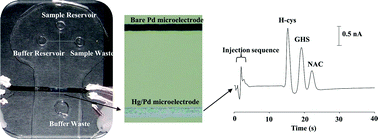Use of microchip electrophoresis and a palladium/mercury amalgam electrode for the separation and detection of thiols
Abstract
This paper describes the use of microchip

* Corresponding authors
a
Saint Louis University, Department of Chemistry, 3501 Laclede Avenue, St. Louis, MO, USA
E-mail:
martinrs@slu.edu
Fax: +314-977-2521
Tel: +314-977-2836
This paper describes the use of microchip

 Please wait while we load your content...
Something went wrong. Try again?
Please wait while we load your content...
Something went wrong. Try again?
C. Antwi, A. S. Johnson, A. Selimovic and R. S. Martin, Anal. Methods, 2011, 3, 1072 DOI: 10.1039/C1AY05055A
To request permission to reproduce material from this article, please go to the Copyright Clearance Center request page.
If you are an author contributing to an RSC publication, you do not need to request permission provided correct acknowledgement is given.
If you are the author of this article, you do not need to request permission to reproduce figures and diagrams provided correct acknowledgement is given. If you want to reproduce the whole article in a third-party publication (excluding your thesis/dissertation for which permission is not required) please go to the Copyright Clearance Center request page.
Read more about how to correctly acknowledge RSC content.
 Fetching data from CrossRef.
Fetching data from CrossRef.
This may take some time to load.
Loading related content
